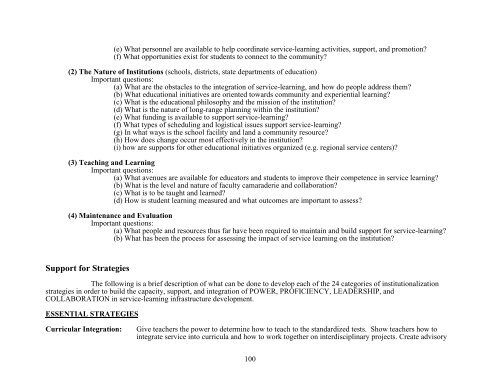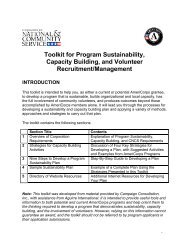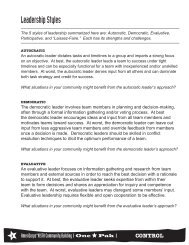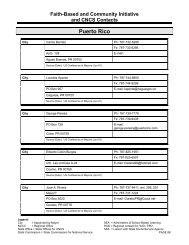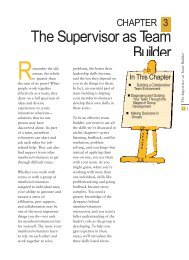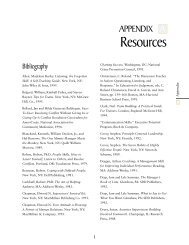MAKE IT LAST FOREVER: THE ... - National Service Resource Center
MAKE IT LAST FOREVER: THE ... - National Service Resource Center
MAKE IT LAST FOREVER: THE ... - National Service Resource Center
You also want an ePaper? Increase the reach of your titles
YUMPU automatically turns print PDFs into web optimized ePapers that Google loves.
(e) What personnel are available to help coordinate service-learning activities, support, and promotion?<br />
(f) What opportunities exist for students to connect to the community?<br />
(2) The Nature of Institutions (schools, districts, state departments of education)<br />
Important questions:<br />
(a) What are the obstacles to the integration of service-learning, and how do people address them?<br />
(b) What educational initiatives are oriented towards community and experiential learning?<br />
(c) What is the educational philosophy and the mission of the institution?<br />
(d) What is the nature of long-range planning within the institution?<br />
(e) What funding is available to support service-learning?<br />
(f) What types of scheduling and logistical issues support service-learning?<br />
(g) In what ways is the school facility and land a community resource?<br />
(h) How does change occur most effectively in the institution?<br />
(i) how are supports for other educational initiatives organized (e.g. regional service centers)?<br />
(3) Teaching and Learning<br />
Important questions:<br />
(a) What avenues are available for educators and students to improve their competence in service learning?<br />
(b) What is the level and nature of faculty camaraderie and collaboration?<br />
(c) What is to be taught and learned?<br />
(d) How is student learning measured and what outcomes are important to assess?<br />
(4) Maintenance and Evaluation<br />
Important questions:<br />
(a) What people and resources thus far have been required to maintain and build support for service-learning?<br />
(b) What has been the process for assessing the impact of service learning on the institution?<br />
Support for Strategies<br />
The following is a brief description of what can be done to develop each of the 24 categories of institutionalization<br />
strategies in order to build the capacity, support, and integration of POWER, PROFICIENCY, LEADERSHIP, and<br />
COLLABORATION in service-learning infrastructure development.<br />
ESSENTIAL STRATEGIES<br />
Curricular Integration:<br />
Give teachers the power to determine how to teach to the standardized tests. Show teachers how to<br />
integrate service into curricula and how to work together on interdisciplinary projects. Create advisory<br />
100


